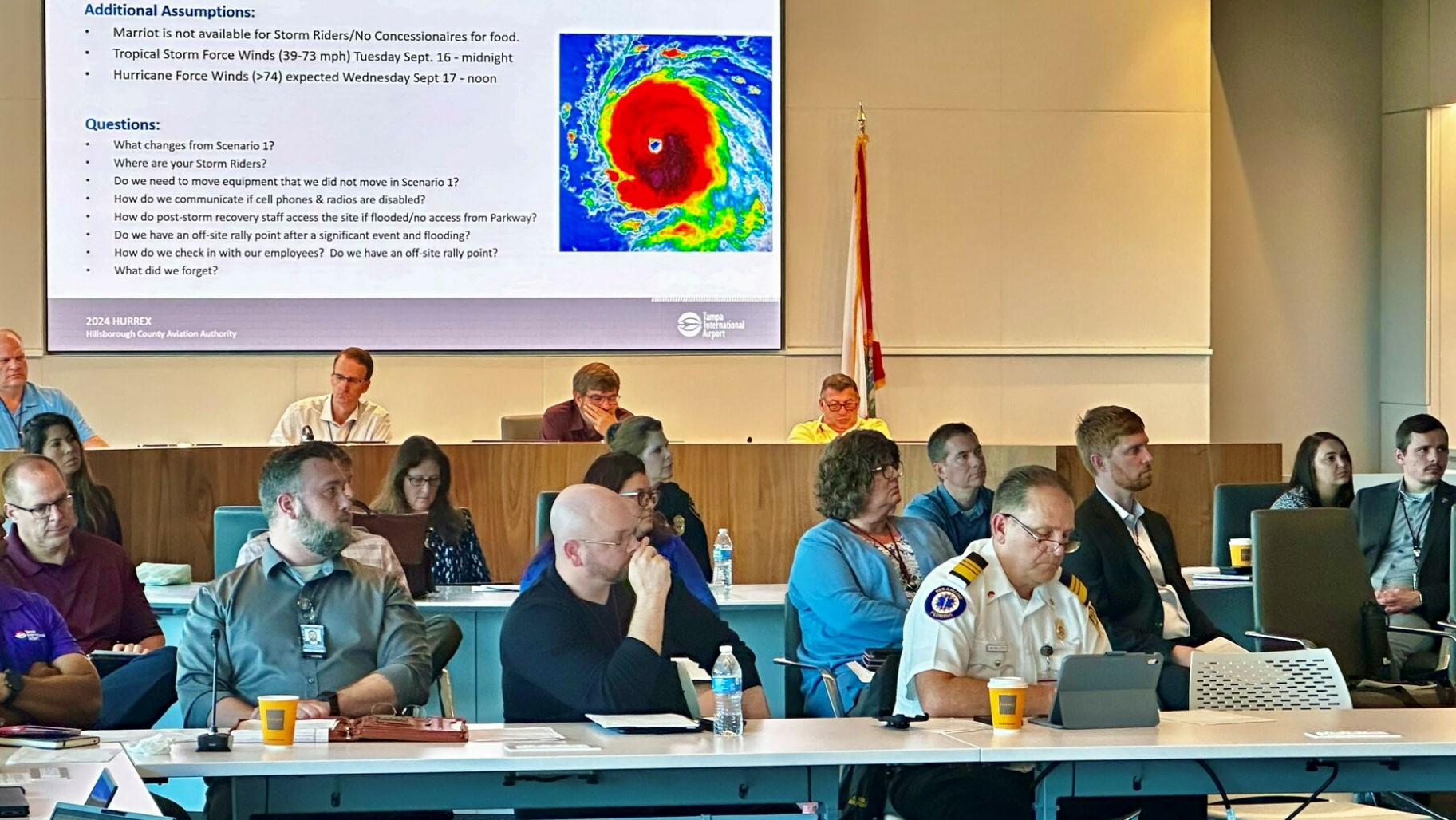With weather experts predicting an extremely active 2024 hurricane season between June 1 and Nov. 30, Tampa International Airport staff have been hard at work preparing for potentially disruptive storms. Let’s learn more about how TPA prepares for extreme weather.
Last August, TPA closed ahead of Hurricane Idalia, a storm that passed off the coast of Tampa Bay and hit the Big Bend region as a Category 4. Idalia’s rapid intensification over the Gulf of Mexico led to flooding around the Tampa Bay region as the hurricane made its way north.
The Airport was able to reopen the following day, underscoring the importance of being well-prepared for the possible effects of major storms – even when Tampa Bay isn’t facing a direct hit.
“We’ve learned through experience and insight from the National Weather Service to anticipate each storm and to take them all seriously, whether that event is forecast for the Tampa Bay area or close enough to have some effect,” TPA Vice President of Operations Benjamin Robins said. “Even the slightest deviation from a predicted path can have dire consequences, and we must be ready for many different outcomes.”
Annual preparations include readiness exercises, checking facility preparedness, and comprehensively reviewing supplies. This past week, TPA held a hurricane scenario tabletop exercise with Hillsborough County Emergency Management, Tampa Fire Rescue, the National Weather Service, and other partners participating.
As part of all storm readiness, Airport officials make the safety of TPA’s employees, partners and passengers their primary focus. Protecting the facilities and preparing to reopen as quickly as possible are also considerations, so that the Airport may restore the safe movement of passengers and cargo and assist with getting aid to affected communities.
The National Oceanic and Atmospheric Administration has forecast an above-average season this year, predicting between 17 and 25 named storms and 8 to 13 hurricanes, with 4 to 7 of those being Category 3 or higher.
The Hillsborough County Aviation Authority, which runs TPA and Hillsborough County’s three publicly owned general aviation airports, monitors potentially threatening storms and begins preparations long before the National Hurricane Center’s cone of uncertainly includes Tampa Bay.
Working with NOAA, Hillsborough County, the City of Tampa, the Federal Aviation Administration, the Transportation Safety Administration and other Airport partners, staff begin formulating how to respond to situations days or even weeks in advance.
“We take many factors into account when planning how to deal with conditions, including whether we will have to suspend operations at the Airport. Everyone’s safety is our top priority, and we need to allow ourselves plenty of time to button up for the worst of it but also anticipate our needs so that we may reopen quickly,” Robins said.
Major considerations for the Airport’s response include when sustained winds reach 50 m.p.h., because aircraft and critical Airport systems cannot function above that threshold. Suspending service at TPA is determined based on a storm’s timing and conditions. A decision has to be made well before stronger winds arrive so that workers may secure Airport infrastructure and ensure passengers and employees have time to get home or evacuate, if necessary.
After the storm, workers must have time to assess potential damage before reopening the airport. Although the Airport’s drainage system is designed to keep water off runways, taxiways and airfield facilities, heavy rain or storm surge may temporarily flood all or parts of the airfield surfaces. Getting the water to drain sufficiently may take time, affecting when normal operations may resume.
“TPA closely coordinates with its partners for reopening based on roadway safety, facility readiness and staffing,” Robins said. “Even though the immediate area around the airport may be traversable, areas where Airport and partner employees live may not. We have to account for a host of challenges in order to restart normal operations and assist our community.”
Here’s a look at how TPA prepares ahead of a shutdown, like the Airport did for Hurricane Ian in 2022:
Florida’s summer months can always lead to storm-related delays that may affect air travel plans. Here are some tips to help you keep up to date on conditions during these rainy months:
CHECK THE FORECAST: Before coming the Airport, be sure to check the weather forecast for more than just the day you’re flying. Check the entire course of your trip, both here and at your destination. You’ll get an indication of any problems that may come up, or whether a storm system is heading your way during your travels.
CALL YOUR AIRLINE: Your airline will always have the latest updates on your flight, so if it looks like your plans may be affected, call your air carrier ahead of time. The airline will have current information about your route and will be informed when flight operations will be affected. If your airline has an app or online chat feature, those can be faster than using the phone when hundreds of people are looking to be rebooked.
BE AN EARLY BIRD: You should always aim to be at the Airport two hours before a domestic flight and three hours before an international flight, but it’s especially true during Tampa Bay’s normal, rainy summer season. Thunderstorms tend to kick in across the region during the afternoon, causing possible delays and cancellations. To avoid these storms, try to schedule your flights earlier in the morning before the rain typically arrives.
MAKE A PLAN: Have a plan in place for family, pets, property and more in case you can’t easily get where you want to be in the event of a delay or cancellation. Considering what you may do in such circumstances should be part of revisiting your emergency plan each season. The Airport is not equipped to serve as a public shelter in the event of a closure, so please don’t bring your pets and cars on-site to stay safe from a storm. Information about emergency shelters, evacuation zones, storm preparation and more is available from the Hillsborough County government’s storm safety webpage. TPA Police Officers and Guest Services Representatives will help direct travelers who need shelter to county-run resources.
CHECK SOCIAL MEDIA: If a tropical storm or hurricane threatens TPA, the Airport will share the latest information on its X account (formerly Twitter) at x.com/FlyTPA . Updates will also be posted at TampaAirport.com.
BE PATIENT: No one likes it when foul weather ruins travel plans, but please try not to take it out on others. Airline and Airport staff want to help, but please remember that they are trying to help everyone else, too. Visit our Information Desk on the third floor of the Main Terminal to learn about helpful amenities like our Traveler’s Aid station, where our pet relief areas are located and to learn more about our expansive shopping and dining locations.




























